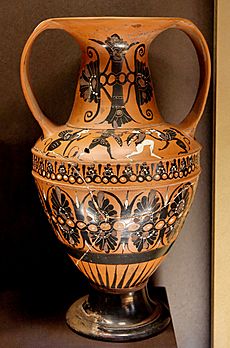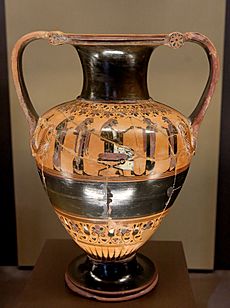Nikosthenic amphora facts for kids

A Nikosthenic amphora is a special type of Attic (meaning from Athens, Greece) pottery vase. It was created in the late 500s BC by a potter named Nikosthenes. These vases were made especially to be sold to the Etruscans, an ancient people who lived in what is now Italy.
These unique vases were inspired by Etruscan pottery called Bucchero. The Nikosthenic amphora is a famous product from the workshop run by Nikosthenes and later by Pamphaios.
Contents
What Makes a Nikosthenic Amphora Special?
Nikosthenic amphorae have a few key features that make them stand out. They have a distinct, angular body shape. Their handles are also very broad and flat.
The Etruscan vases that inspired them were usually painted black. However, the Greek Nikosthenic amphorae were decorated using the black-figure style. This means the designs were painted in black silhouette on the natural reddish clay.
Most of these vases have been found in a place called Caere in Etruria. But many other types of pottery made by Nikosthenes were found in a different place called Vulci. This suggests that the Nikosthenic amphora was specifically made for people in or near Caere. It shows that Nikosthenes was a very good businessman! It also means there was a good system of traders who helped sell these vases.
Nikosthenes created or introduced several different vase shapes. But the Nikosthenic amphora is his most well-known invention.
The Clay and Decorations
The clay used for Nikosthenic amphorae is a bright orange-red color. This made it a perfect background for the black-figure painting style. The way they were decorated could vary a lot.
Sometimes, the vases had two or three separate bands, called friezes. These bands often featured designs of plants and animals. Other times, the pictures would cover the entire body of the vase.
The Artists Behind the Vases
It seems that most, or even all, Nikosthenic amphorae were painted by an artist known as the N Painter. Some experts even think that the N Painter might have been Nikosthenes himself!
The production of these amphorae started around 530 to 520 BC. They continued to be made even after Nikosthenes, under his successor, Pamphaios. By then, they were decorated in the red-figure style, where the background is painted black and the figures are left in the natural red color of the clay. Production of Nikosthenic amphorae stopped between 500 and 490 BC.
See also
 In Spanish: Ánfora nicosténica para niños
In Spanish: Ánfora nicosténica para niños


